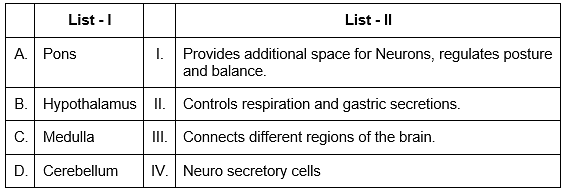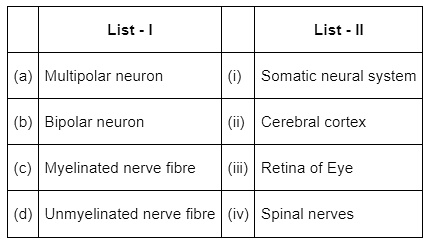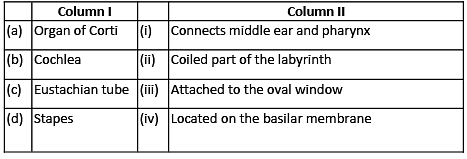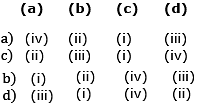NEET Previous Year Questions (2016-2024): Neural Control & Coordination | Biology Class 11 PDF Download
2024
Q1: Given below are two statements: (NEET 2024)
Statement I: The cerebral hemispheres are connected by nerve tract known as corpus callosum.
Statement II: The brain stem consists of the medulla oblongata, pons and cerebrum.
In the light of the above statements, choose the most appropriate answer from the options given below:
(a) Both Statement I and Statement II are correct.
(b) Both Statement I and Statement II are incorrect.
(c) Statement I is correct but Statement II is incorrect.
(d) Statement I is incorrect but Statement II is correct.
Ans: (c)
Statement I describes the corpus callosum, a structure in the brain. The corpus callosum is a large bundle of nerve fibers that connects the two cerebral hemispheres, allowing for communication between them. This statement is correct.
Statement II mentions the brain stem and lists its components as the medulla oblongata, pons, and cerebrum. The error here is in including the cerebrum as part of the brain stem. In actuality, the brain stem consists of the medulla oblongata, the pons, and the midbrain, not the cerebrum. The cerebrum is part of the forebrain and is responsible for higher cognitive functions such as thinking, perceiving, planning, and understanding language. Therefore, Statement II is incorrect.
Based on the analysis above, the correct answer is: Option C: Statement I is correct but Statement II is incorrect.
Q2: Match List I with List II: (NEET 2024)
Choose the correct answer from the options given below :
(a) A-II, B-III, C-I, D-IV
(b) A-III, B-IV, C-II, D-I
(c) A-I, B-III, C-II, D-IV
(d) A-II, B-I, C-III, D-IV
Ans: (b)
Sol: To match List I with List II correctly, we start by identifying the function of each brain region described in List I and match these descriptions to the corresponding functions stated in List II:
Pons: The pons is part of the brainstem located between the midbrain and the medulla oblongata. It principally acts as a bridge connecting various parts of the brain, and it is also involved in controlling essential functions like sleep and respiration.
Hypothalamus: The hypothalamus is a small portion at the base of the brain that plays a crucial role in hormone release and regulation of essential bodily functions, including temperature control, thirst, hunger, sleep, mood, and sexual behavior. It contains several neurosecretory cells that produce hormones.
Medulla: The medulla oblongata, also part of the brainstem, primarily controls autonomic functions such as breathing, heart rate, and digestion (including gastric secretions).
Cerebellum: The cerebellum is located at the back of the brain and is responsible for controlling motor skills, balance, coordination, and posture. It helps refine the movements dictated by the motor cortex.
Now, let's match these descriptions to those listed in List II:
A. Pons should match with "Connects different regions of the brain." - this corresponds to III.
B. Hypothalamus should match with "Neurosecretory cells." - this corresponds to IV.
C. Medulla should match with "Controls respiration and gastric secretions." - this corresponds to II.
D. Cerebellum should match with "Provides additional space for Neurons, regulates posture and balance." - this corresponds to I.
When we look at the given options:
Option A: A-II, B-III, C-I, D-IV (wrong)
Option B: A-III, B-IV, C-II, D-I (correct)
Option C: A-I, B-III, C-II, D-IV (wrong)
Option D: A-II, B-I, C-III, D-IV (wrong)
The correct answer is Option B: A-III, B-IV, C-II, D-I.
2023
Q1: Match List I with List II with respect to human eye. (NEET 2023)

Choose the correct answer from the options given below:
(a) A-III, B-I, C-IV, D-II
(b) A-IV, B-III, C-II, D-I
(c) A-I, B-IV, C-III, D-II
(d) A-II, B-I, C-III, D-IV
Ans: (a)
Option (a) is the correct answer because
(i) Fovea is the point of greatest visual acuity or resolution.
(ii) Iris is the visible coloured portion of the eye that regulates diameter of pupil.
(iii) Blind spot is the point where optic nerve leaves the eye-ball and photoreceptor cells are absent
(iv) Sclera is the external layer of eye formed of dense connective tissue.
Q2: The parts of human brain that helps in regulation of sexual behaviour, expression of excitement, pleasure, rage, fear etc. are: (2023)
(a) Corpora quadrigemina and hippocampus
(b) Brain stem and epithalamus
(c) Corpus callosum and thalamus
(d) Limbic system and hypothalamus
Ans: (d)
- The limbic system, which includes structures such as the amygdala and hippocampus, plays a significant role in regulating emotions, including fear, pleasure, and anger. The hypothalamus, another component of the limbic system, is involved in various functions, including the regulation of sexual behavior and responses to pleasure and excitement. Therefore, option D is correct.
- Option (A), (B) and (C) are not correct because corpora quadrigemina is a part of the midbrain and consists of four round swellings. Corpus callosum is a tract of nerve fibres that connects right and left cerebral hemispheres. Thalamus is a major coordinating centre in the forebrain for sensory and motor signalling. Midbrain, pons and medulla oblongata together form the brain stem.
2022
Q1: Select the incorrect statement regarding synapses: (NEET 2022 Phase 1)
(a) Electrical current can flow directly from one neuron into the other across the electrical synapse.
(b) Chemical synapses use neurotransmitters.
(c) Impulse transmission across a chemical synapse is always faster than that across an electrical synapse.
(d) The membranes of presynaptic and postsynaptic neurons are ibn close proximity in an electrical synapse.
Ans: (c)
Option (c) is the correct answer as impulse transmission across an electrical synapse is always faster than that across a chemical synapse.
→ Chemical synapses use chemicals for transmission which are known as neurotransmitters.
→ The membranes of presynaptic and postsynaptic neurons are in close proximity in an electrical synapse.
→ In an electrical synapse, the transmission of the impulse occurs in the form of an electrical current from one neuron to the next neuron.
Q2: Match List-I with List - II : (NEET 2022 Phase 2)

Choose the correct answer from the options given below :
(a) (a) - (ii), (b) - (iii), (c) - (iv), (d) - (i)
(b) (a) - (iii), (b) - (i), (c) - (iv), (d) - (ii)
(c) (a) - (ii), (b) - (iv), (c) - (iii), (d) - (i)
(d) (a) - (ii), (b) - (iii), (c) - (i), (d) - (iv)
Ans: (a)
Option (a) is the correct answer because
(a) Multipolar neurons are present in cerebral cortex.
(b) Bipolar neurons are found in the retina of the eye.
(c) Myelinated nerve fibres are found in spinal and cranial nerves
(d) Unmyelinated nerve fibres are commonly found in autonomous and somatic neural systems.
2020
Q1: Match the following columns and select the correct option. (NEET 2020)

Ans: (a)
- Organ of Corti (a) is located on the basilar membrane (iv).
- Cochlea (b) is the coiled part of the labyrinth (ii).
- Eustachian tube (c) connects the middle ear and pharynx (i).
- Stapes (d) is attached to the oval window (iii).
2019
Q1: Which of the following statements is correct? (NEET 2019)
(a) Cornea consists of dense matrix of collagen and is the most sensitive portion of the eye.
(b) Cornea is an external, transparent and protective proteinacious covering of the eye-ball.
(c) Cornea consists of dense connective tissue of elastin and can repair itself.
(d) Cornea is convex, transparent layer which is highly vascularised.
Ans: (b)
- Option A: This statement is incorrect. The cornea is a transparent, avascular layer at the front of the eye that covers the iris, pupil, and anterior chamber.
- Option B: This statement is partially correct. The cornea is made up of a dense matrix of collagen fibers, but it is not the most sensitive portion of the eye. The most sensitive part of the eye is the conjunctiva, which is the thin, transparent layer that covers the white part of the eye and the inner surfaces of the eyelids.
- Option C: This statement is incorrect. The cornea is an external, transparent, and protective proteinaceous covering of the eye-ball.
- Option D: This statement is incorrect. The cornea is composed of dense connective tissue of collagen and cannot repair itself. Any injury to the cornea may result in permanent scarring or loss of vision.
Q2: Which part of the brain is responsible for thermoregulation? (NEET 2019)
(a) Medulla oblongata
(b) Cerebrum
(c) Hypothalamus
(d) Corpus callosum
Ans: (c)
Hypothalamus is responsible for thermoregulation.
2018
Q1: Nissl’s bodies are mainly composed of (NEET 2018)
(a) Proteins and lipids
(b) DNA and RNA
(c) Nucleic acids and SER
(d) Free ribosomes and RER.
Ans: (d)
Nissl granules are composed of free ribosomes and RER. They are responsible for protein synthesis.
Q2: The transparent lens in the human eye is held in its place by (NEET 2018)
(a) Ligaments attached to the ciliary body
(b) Ligaments attached to the iris
(c) Smooth muscles attached to the iris
(d) Smooth muscles attached to the ciliary body.
Ans: (a)
In the human eye, the lens is held in its place by suspensory ligament attached to the ciliary body.
Q3: Which of the following structures or regions is incorrectly paired with its functions? (NEET 2018)
| (a) Medulla oblongata | Controls respiration and cardiovascular reflexes |
| (b) Limbic system | Consists of fibre tracts that interconnect different regions of brain controls movement |
| (c) Hypothalamus | Production of releasing hormones and regulation of temperature, hunger and thirst |
| (d) Corpus callosum | Band of fibers connecting left and right cerebral hemispheres |
Ans: (b)
- Medulla oblongata possess important centres for : Respiration, Cardiovascular reflexes, Gastric secretions.
- Corpus callosum : It is a tract of nerve fibres by which the hemispheres are connected with each other.
- Hypothalamus : It is centre for body temperature, urge for eating(hunger) and drinking (thirst).
- The limbic system (emotional motor system) is responsible for the experience and expression of emotion but not movement. It is located in the core of the brain and includes the amygdala, hippocampus and hypothalamus.
2017
Q1: Myelin sheath is produced by (NEET 2017)
(a) Astrocytes and Schwann cells
(b) Oligodendrocytes and osteoclasts
(c) Osteoclasts and astrocytes
(d) Schwann cells and oligodendrocytes.
Ans: (d)
Myelin sheath wrapped around the nerve axon. Oligodendrocytes are neuroglial cells which produce myelin sheath in central nervous system while Schwann cell produces myelin sheath in peripheral nervous system.
Q2: Receptor sites for neurotransmitters are present on (NEET 2017)
(a) Pre-synaptic membrane
(b) Tips of axons
(c) Post-synaptic membrane
(d) Membranes of synaptic vesicles.
Ans: (c)
Pre-synaptic membrane is involved in the release of neurotransmitter in the chemical synapse. The receptors sites for neurotransmitters are present on postsynaptic membrane of neuron.
Q3: Good vision depends on adequate intake of carotene rich food.
Select the best option from the following statements. (NEET 2017)
(1) Vitamin A derivatives are formed from carotene.
(2) The photopigments are embedded in the membrane discs of the inner segment.
(3) Retinal is a derivative of vitamin A.
(4) Retinal is a light absorbing part of all the visual photopigments.
(a) (1), (3) and (4)
(b) (1) and (3)
(c) (2), (3) and (4)
(d) (1) and (2)
Ans: (a)
- Vitamins A derivatives are formed from carotene which is a type of pigment that is found in certain foods, such as carrots, sweet potatoes, and spinach. The body converts carotene into vitamin A, which is essential for good vision.
- Retinal is a derivative of vitamin A and it is a light-absorbing part of all the visual photopigments. Photopigments are embedded in the membrane discs of the inner segment of the rod and cone cells in the retina.
Therefore, options (1), (3), and (4) are correct.
2016
Q1: Choose the correct statement. (NEET 2016 Phase 2)
(a) Nociceptors respond to changes in pressure.
(b) Meissner's corpuscles are thermoreceptors.
(c) Photoreceptors in the human eye are depolarised during darkness and become hyperpolarised in response to the light stimulus.
(d) Receptors do not produce graded potentials.
Ans: (c)
Photoreceptors in human eye are unique because they are only type of sensory cells that are relatively depolarised (about –35mV) when it is at rest (i.e., in the dark), and hyperpolarised (to about – 70mV) in response to adequate light stimulus. Nociceptors respond to potentially damaging stimuli that result in pain. Meissner’s corpuscles are a type of mechanoreceptor, responsible for touch sensitivity. Receptors generally produce graded potentials called receptor potentials.
Q2: Photosensitive compound in human eye is made up of (NEET 2016 Phase 1)
(a) Guanosine and Retinol
(b) Opsin and Retinal
(c) Opsin and Retinol
(d) Transducin and Retinene
Ans: (b)
The rods contain a photosensitive pigment called the rhodopsin. Rhodopsin is composed of opsin and retinene. The opsin is a protein and is called scotopsin in rhodopsin. The retinene is an aldehyde of vitamin A and is called retinal.
2015
Q1: In mammalian eye, the 'fovea' is the center of the visual field, where: (NEET 2015 / AIPMT 2015)
(a) The optic nerve leaves the eye
(b) Only rods are present
(c) More rods than cones are found
(d) High density of cones occur, but has no rods.
Ans: (d)
A small oval, yellowish area of the retina lying exactly opposite the centre of the cornea is named the macula lutea or yellow spot which has at its middle a shallow depression, the fovea centralis. The fovea centralis has cone cells only. It is devoid of rods and blood vessels. The fovea centralis is the place of most distinct vision.
Q2: Destruction of the anterior horn cell of the spinal cord would result in loss of: (NEET 2015 / AIPMT 2015)
(a) Voluntary motor impulses
(b) Commissural impulses
(c) Integrating impulses
(d) Sensory impulses
Ans: (a)
The anterior horns of spinal cord contains cells with fibres that form the anterior (motor) root end and are essential for the voluntary and reflex activity of muscles they innervate. If the anterior horn motor cells are destroyed, the nerves cannot regenerate and muscles are never useful again.
Q3: A gymnast is able to balance his body upside down even in the total darkness because of: (NEET / AIPMT 2015 Cancelled Paper )
(a) Vestibular apparatus
(b) Tectorial membrane
(c) Organ of corti
(d) Cochlea
Ans: (a)
Vestibular apparatus has specific receptors called crista and macula to maintain the balance and posture of body.
Q4: Which of the following regions of the brain is incorrectly paired with its function? (NEET / AIPMT 2015 Cancelled Paper )
(a) Cerebellum – language comprehension
(b) Corpus callosum – communication between the left and right cerebral cortices
(c) Cerebrum – calculation and contemplation
(d) Medulla oblongata – homeostatic control
Ans: (a)
Cerebellum maintains the balance and body posture. It is not concerned with logical part.
2014
Q1: Which one of the following statements is not correct? (NEET 2014 / AIPMT 2014 )
(a) Retinal is the light absorbing portion of visual photo pigments.
(b) In retina the rods have the photopigment rhodopsin while cones have three different photopigments.
(c) Retinal is a derivative of Vitamin C.
(d) Rhodopsin is the purplish red protein present in rods only.
Ans: (c)
Retinal is a derivative of vitamin A. Retinal is a polyene chromophore, and bound to proteins called opsins, is the chemical basis of animal vision. Bound to proteins called type 1 rhodopsins, retinal allows certain microorganisms to convert light into metabolic energy.
Q2: Injury localized to the hypothalamus would most likely disrupt: (2014)
(a) Short - term memory.
(b) Co-ordination during locomotion.
(c) Executive functions, such as decision making.
(d) Regulation of body temperature.
Ans: (d)
The hypothalamus is a highly complex structure in the brain that regulates many important brain chemicals. The hypothalamus is responsible for hormone production. The hormones produced by this area govern body temperature, thirst, hunger, sleep, circadian rhythm, moods, sex drive, and the release of other hormones in the body. This area of the brain controls the pituitary gland and other glands in the body.
|
181 videos|361 docs|148 tests
|
FAQs on NEET Previous Year Questions (2016-2024): Neural Control & Coordination - Biology Class 11
| 1. What is the role of the nervous system in controlling and coordinating body functions? |  |
| 2. How does the brain communicate with other parts of the body through the nervous system? |  |
| 3. What are the main components of the central nervous system and peripheral nervous system? |  |
| 4. How do neurotransmitters help in transmitting signals between neurons in the nervous system? |  |
| 5. How does the autonomic nervous system regulate involuntary functions such as heart rate and digestion? |  |

|
Explore Courses for NEET exam
|

|


















